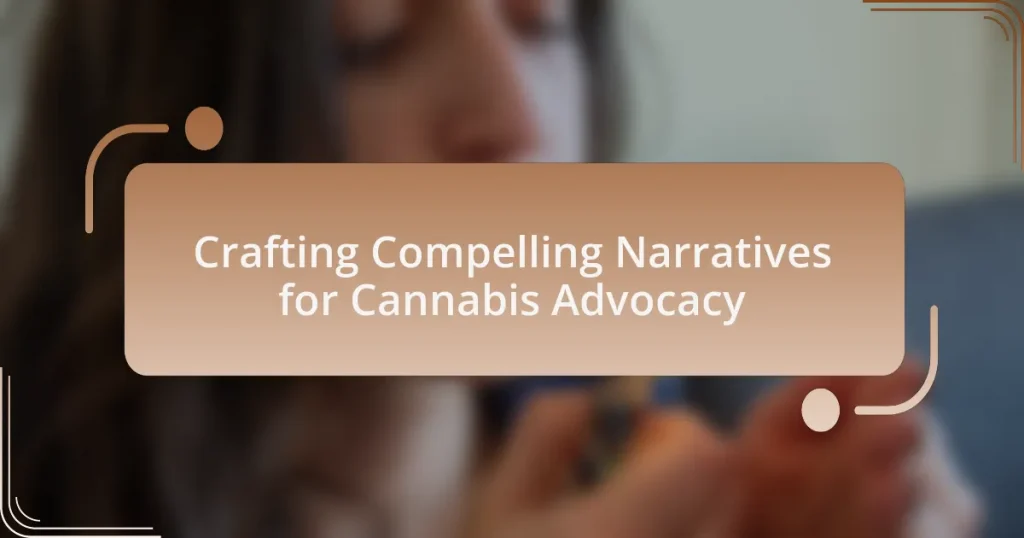The article focuses on crafting compelling narratives for cannabis advocacy, emphasizing the importance of storytelling in influencing public perception and policy regarding cannabis legalization. It discusses how personal experiences, such as those of patients benefiting from cannabis, can humanize the issue and create emotional connections that resonate with audiences. Key elements of effective narratives, including relatable characters, clear conflict, and emotional engagement, are outlined, along with strategies for tailoring messages to different audiences, including policymakers and the general public. The article also addresses challenges in advocacy, such as stigma and legal complexities, and highlights best practices for integrating data and personal stories to enhance the impact of cannabis advocacy narratives.

What are Compelling Narratives in Cannabis Advocacy?
Compelling narratives in cannabis advocacy are stories that effectively communicate the benefits and importance of cannabis legalization and reform. These narratives often highlight personal experiences, such as patients finding relief from chronic pain or seizures through cannabis use, which resonate emotionally with audiences. For instance, the story of Charlotte Figi, a young girl with Dravet syndrome, who experienced significant seizure reduction through CBD oil, has been pivotal in shifting public perception and influencing legislation. Such narratives not only humanize the issue but also provide relatable contexts that can sway public opinion and policymakers, demonstrating the real-world impact of cannabis on individuals and communities.
Why are narratives important for cannabis advocacy?
Narratives are important for cannabis advocacy because they humanize the issue and create emotional connections that can influence public perception and policy. By sharing personal stories of individuals affected by cannabis laws, advocates can illustrate the real-life consequences of prohibition, such as criminalization and health disparities. Research shows that narratives can be more persuasive than statistics alone; for instance, a study published in the journal “Health Communication” found that personal stories significantly increased support for cannabis legalization among undecided voters. This demonstrates that effective storytelling can mobilize support and drive legislative change in favor of cannabis reform.
How do narratives influence public perception of cannabis?
Narratives significantly influence public perception of cannabis by shaping beliefs, attitudes, and behaviors surrounding its use. For instance, positive narratives that highlight medicinal benefits and personal success stories can lead to increased acceptance and support for legalization, as evidenced by surveys indicating that states with strong advocacy narratives often see higher approval ratings for cannabis initiatives. Conversely, negative narratives focusing on criminality and health risks can perpetuate stigma and resistance to reform, as shown in research by the Pew Research Center, which found that public opinion is heavily swayed by the framing of cannabis-related discussions in media and political discourse.
What role do personal stories play in cannabis advocacy narratives?
Personal stories play a crucial role in cannabis advocacy narratives by humanizing the issue and fostering emotional connections. These narratives often illustrate the real-life impacts of cannabis use, such as relief from chronic pain or improvement in quality of life for patients, which can resonate deeply with audiences. Research indicates that personal testimonies can significantly influence public perception and policy decisions; for instance, a study published in the Journal of Health Communication found that personal stories are more persuasive than statistics alone in changing attitudes toward health-related issues. By sharing individual experiences, advocates can effectively challenge stigma and promote understanding, ultimately driving support for cannabis legalization and reform.
What elements make a narrative compelling?
A compelling narrative includes relatable characters, a clear conflict, emotional engagement, and a strong resolution. Relatable characters allow the audience to connect personally, while a clear conflict drives the story forward and maintains interest. Emotional engagement is crucial as it evokes feelings that resonate with the audience, making the narrative memorable. A strong resolution provides closure and reinforces the narrative’s message, ensuring that the audience leaves with a lasting impression. Research indicates that narratives with these elements are more effective in influencing attitudes and behaviors, particularly in advocacy contexts like cannabis, where personal stories can significantly impact public perception and policy change.
How does emotional appeal enhance cannabis advocacy narratives?
Emotional appeal enhances cannabis advocacy narratives by creating a deeper connection with the audience, fostering empathy and understanding. This connection is crucial as it allows advocates to share personal stories of individuals who have benefited from cannabis, such as patients experiencing relief from chronic pain or anxiety. Research indicates that narratives that evoke emotions can significantly influence attitudes and behaviors; for instance, a study published in the Journal of Health Communication found that emotionally charged stories are more persuasive than purely factual presentations. By leveraging emotional appeal, cannabis advocacy can effectively challenge stigma, promote awareness, and drive policy change, ultimately leading to greater acceptance and support for cannabis use.
What techniques can be used to structure a compelling narrative?
Techniques to structure a compelling narrative include the use of a clear plot arc, character development, and emotional engagement. A clear plot arc typically follows a structure of exposition, rising action, climax, falling action, and resolution, which helps maintain audience interest and understanding. Character development allows the audience to connect with relatable figures, enhancing emotional investment in the story. Emotional engagement can be achieved through storytelling techniques such as vivid imagery, personal anecdotes, and relatable conflicts, which resonate with the audience’s experiences and values. These techniques are supported by narrative theory, which emphasizes the importance of structure and emotional connection in effective storytelling.
How can narratives be tailored for different audiences?
Narratives can be tailored for different audiences by understanding their values, beliefs, and preferences. For instance, when addressing policymakers, narratives should emphasize data-driven outcomes and public health benefits, as evidenced by studies showing reduced opioid prescriptions in states with legal cannabis. Conversely, when targeting recreational users, the focus can shift to personal stories and lifestyle benefits, which resonate more with that demographic. Tailoring involves adjusting language, tone, and content to align with the audience’s interests, ensuring the message is relevant and engaging.
What strategies work best for engaging policymakers?
The best strategies for engaging policymakers include building relationships, providing clear and concise information, and utilizing data-driven arguments. Building relationships fosters trust and opens lines of communication, which is essential for effective advocacy. Clear and concise information ensures that policymakers can quickly grasp the key points, while data-driven arguments, such as statistics on cannabis legalization impacts, provide credible evidence that can influence decision-making. For instance, a study by the National Conference of State Legislatures found that states with legalized cannabis experienced a significant increase in tax revenue, which can be a compelling point for policymakers focused on budgetary concerns.
How can narratives resonate with the general public?
Narratives can resonate with the general public by aligning with their values, emotions, and experiences. When narratives reflect shared beliefs or address common concerns, they create a sense of connection and relatability. For instance, storytelling that highlights personal experiences with cannabis can humanize the issue, making it more accessible and engaging. Research indicates that emotional storytelling can increase empathy and understanding, as seen in studies like “The Role of Narrative in Health Communication” by Green and Brock, which demonstrates that narratives can effectively influence public perception and attitudes.
What challenges exist in crafting narratives for cannabis advocacy?
Crafting narratives for cannabis advocacy faces several challenges, primarily stemming from stigma, legal complexities, and diverse stakeholder perspectives. The stigma surrounding cannabis use, rooted in historical misconceptions and societal biases, complicates the acceptance of advocacy narratives. Legal complexities, including varying regulations across jurisdictions, create hurdles in presenting a unified message. Additionally, the diverse perspectives of stakeholders—ranging from medical professionals to recreational users—make it difficult to create a narrative that resonates universally. These challenges necessitate careful consideration and strategic communication to effectively advocate for cannabis.
How can advocates overcome stigma associated with cannabis narratives?
Advocates can overcome stigma associated with cannabis narratives by promoting education and awareness about the benefits and realities of cannabis use. Research indicates that informed discussions can shift public perception; for instance, a study published in the Journal of Psychoactive Drugs found that increased knowledge about cannabis significantly reduces stigma. By sharing personal stories and scientific evidence, advocates can humanize cannabis users and highlight its medicinal properties, thereby fostering a more accepting environment.
What are common pitfalls to avoid in cannabis advocacy storytelling?
Common pitfalls to avoid in cannabis advocacy storytelling include oversimplification, lack of personal connection, and failure to address counterarguments. Oversimplification can lead to a narrative that does not capture the complexities of cannabis issues, which may alienate informed audiences. A lack of personal connection diminishes the emotional impact of the story, making it less relatable and engaging. Additionally, failing to address counterarguments can weaken the narrative’s credibility, as it may appear one-sided and dismissive of opposing views. These pitfalls can undermine the effectiveness of advocacy efforts by failing to resonate with diverse audiences and missing opportunities for meaningful dialogue.
How can data and research support cannabis advocacy narratives?
Data and research can significantly support cannabis advocacy narratives by providing empirical evidence that validates claims about the benefits and safety of cannabis use. For instance, studies such as the 2017 National Academies of Sciences report found substantial evidence that cannabis can alleviate chronic pain, which strengthens arguments for its medical use. Additionally, research published in the Journal of Psychoactive Drugs indicates that cannabis legalization is associated with reduced opioid overdose deaths, further supporting advocacy for policy changes. These data points not only enhance the credibility of advocacy efforts but also help to counteract misinformation by presenting scientifically-backed facts that resonate with policymakers and the public.
What types of data are most effective in enhancing narratives?
Quantitative data, qualitative data, and anecdotal evidence are the most effective types of data in enhancing narratives. Quantitative data, such as statistics on cannabis use and its effects, provides concrete evidence that can support claims and persuade audiences. For instance, a study published in the Journal of Cannabis Research found that 70% of patients reported improved symptoms after using cannabis, which can be a powerful statistic in advocacy narratives. Qualitative data, including personal testimonials and case studies, adds emotional depth and relatability, making the narrative more compelling. Anecdotal evidence, while less rigorous, can humanize the issue and create a connection with the audience, as seen in various advocacy campaigns that share personal stories of individuals benefiting from cannabis. Together, these data types create a well-rounded narrative that appeals to both logic and emotion, essential for effective advocacy.
How can advocates balance personal stories with factual information?
Advocates can balance personal stories with factual information by integrating emotional narratives that resonate with audiences while supporting them with credible data. This approach allows advocates to humanize their message, making it relatable, while factual information provides the necessary context and legitimacy. For instance, a study published in the Journal of Cannabis Research highlights that personal testimonials can significantly enhance the impact of statistical data, leading to greater audience engagement and understanding. By weaving together personal experiences and verified statistics, advocates create a compelling narrative that informs and inspires action.
What are best practices for sharing cannabis advocacy narratives?
Best practices for sharing cannabis advocacy narratives include using personal stories, focusing on factual information, and engaging with the audience. Personal stories create emotional connections, making the narrative relatable and impactful. Factual information, such as statistics on cannabis benefits or legal changes, provides credibility and supports the narrative. Engaging with the audience through interactive platforms or community events fosters dialogue and encourages broader participation. These methods have been shown to enhance the effectiveness of advocacy efforts, as evidenced by successful campaigns that utilized storytelling and data to influence public perception and policy changes.
How can social media be leveraged for effective narrative sharing?
Social media can be leveraged for effective narrative sharing by utilizing targeted content strategies that engage specific audiences. Platforms like Facebook, Instagram, and Twitter allow advocates to share personal stories, educational materials, and community experiences that resonate with users. For instance, studies show that visual content, such as infographics and videos, increases engagement rates by up to 1200%, making it an effective tool for conveying narratives. Additionally, using hashtags and participating in trending conversations can amplify reach and foster community discussions, thereby enhancing the impact of the narrative shared.
What platforms are most effective for reaching target audiences?
Social media platforms, particularly Facebook, Instagram, and Twitter, are most effective for reaching target audiences in cannabis advocacy. These platforms allow for targeted advertising and community engagement, which are crucial for disseminating information and building support. For instance, a study by the Pew Research Center indicates that 69% of adults in the U.S. use Facebook, making it a prime platform for outreach. Additionally, Instagram’s visual nature is effective for storytelling, which is essential in advocacy efforts. Twitter facilitates real-time communication and mobilization, allowing advocates to engage with audiences quickly and effectively.
What practical tips can enhance cannabis advocacy narratives?
To enhance cannabis advocacy narratives, advocates should focus on storytelling, data-driven arguments, and community engagement. Storytelling personalizes the issue, making it relatable; for instance, sharing personal experiences with cannabis can humanize the narrative and foster empathy. Data-driven arguments provide credibility; studies show that states with legalized cannabis have seen a reduction in opioid prescriptions, which can be cited to support claims about cannabis as a safer alternative. Community engagement builds a coalition of support; organizing local events or forums allows advocates to connect with diverse audiences, amplifying their message and fostering a sense of shared purpose.


